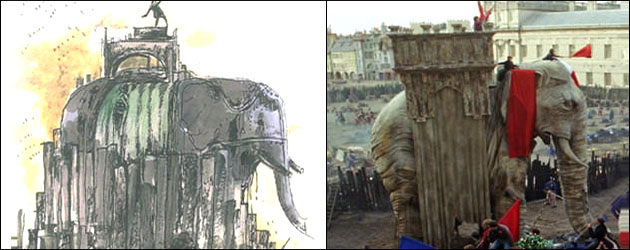Eve Stewart

AS: How do you feel about production design being invisible or visible in films?
ES: If you’re invisible for the bulk of your time then you’ve done a really good job because it hasn’t stuck in somebody’s throat. If you’re invisible eighty percent of the time and twenty percent of the time people go, Whoa! because you’ve introduced them to a new world, I feel that’s a good job.
AS: Do you feel a set can be a character in a movie?
ES: Definitely. It’s a massive illustration and it’s a history-teller. It’s a quicker story-teller than the script. Because people are so quick to assess the status, the history, the mood. They make a complete judgment on what they’re seeing about the person who is involved there. It’s an enormous resource.
AS: What do you think of the future of production design? More and more CG and greenscreens?
ES: No, I think there’s a sort of backlash if anything. I find that people are asking for more and more in-camera. Of course the really big movies are going to stick to doing green but I find that there’s actually more being put in-camera and I think audiences get a bit tired of the kind of glossiness of the non-realism of CG. I think they like a bit of realism where they can connect. Definitely there’s a backlash at the moment.
AS: Do you use a lot of painted backdrops?
ES: I love painted backdrops, yes. I use anything of the old craft. I think people love to see craft that other human beings have made with their own hands. It’s something primal. People understand when another human being’s telling a story visually. However they do it. With painted backdrops, sculpture, what they’re wearing. If something’s too perfect it feels cold, non-engaging.
AS: Have you ever worked on more than one project at a time?
ES: No. They sometimes overlap at the very end. But I like to try to give it my all. And I think a massive part of my job is to support the director all the way through it. You have to dedicate yourself.
AS: When you first worked with Mike Leigh you worked as art director. How was it different working with a production designer as an art director versus working as a production designer?
ES: I was a standby art director so I was on the floor. It was brilliant to fully understand you have to get everything ready and you can’t take short cuts and leave the crew on the floor without extra stuff. It was all-in-all a good background before becoming a designer.
AS: In Mike Leigh films did you ever build sets?
ES: Not for films I art directed. But for Topsy-Turvy much of that was built because none of it existed how it would have been. But then with Vera Drake the majority was locations because Mike likes the history that you get from the real thing. It had ghosts in it and more lumps and bumps. It’s been around the block and that’s always good.
This is a very interesting conversation. Thank you for sharing your insights about the production design and entertainment industry! As a student aspiring to one day work in the entertainment or production industry these insights are very inspiring and helpful in career planning. Wish you the best in all your endeavors! Keep up the incredibly beautiful work.